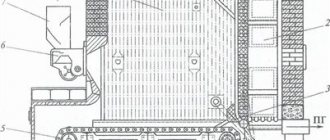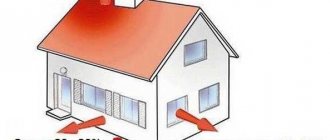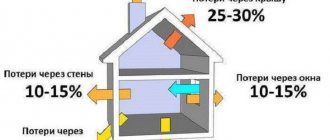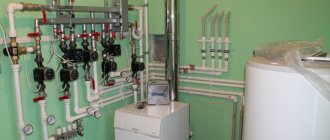Many homeowners are happy to install gas boilers indoors for heating and hot water supply, so as not to depend on the whims of bad weather and pitfalls associated with the operation of municipal heating systems.
In this situation, the correct choice of boiler equipment is of great importance, for which you will need to know how to calculate the power of a gas boiler.
If it exceeds the actual heat loss of the facility, then part of the cost of generating thermal energy will be lost. And units with low heating capacity will not be able to provide households with the required amount of heat.
Boiler load
Boiler load
Post by elika » Mar 16, 2009, 11:27 pm
Re: boiler load
Post by Elena » March 16, 2009, 11:27 pm
Re: boiler load
Post by vbkzk » Mar 16, 2009, 11:27 pm
Re: boiler load
Post by Liapa » Mar 16, 2009, 11:27 pm
Re: boiler load
Post by Sasha » 08 Apr 2009, 16:27
Re: boiler load
Post by Vadim Zykov » 09 Apr 2009, 10:19
Re: boiler load
Post by Anna M » Mar 16, 2010, 11:13 am
Re: boiler load
Post by Patrik » April 20, 2010, 8:17 pm
Re: boiler load
Post by tit_kukushkin » April 26, 2011, 3:41 pm
Hello! We received comments from Rosprirodnadzor on the boiler house MPE project. Please help me figure it out. To calculate emissions in the “Boiler Houses” program, you need to make calculations (calculation of the annual demand for natural fuel) for a hot water boiler (operation map at the link below):
and the remark is as follows: “To calculate the annual need for natural fuel for a hot water boiler, it is necessary to use the hourly heat load (Gcal/hour) required for heating and hot water supply of the residential complex and the administrative building of Russian Railways, and not the average hourly fuel consumption.”
Please help, whoever is fumbling)
Re: Boiler load
Post by Anna_Rostov » April 27, 2011, 07:32
you need to look for the noise characteristics of the burner
Sent after 26 minutes 51 seconds: can be taken by analogy, depending on similar parameters
Responsibility
The forum “Forum for Environmentalists” is publicly accessible to all registered users and operates in compliance with the current legislation of the Russian Federation. The forum administration does not exercise control and cannot be responsible for the information posted by users on the “Forum for Environmentalists” forum. At the same time, the Forum Administration has a sharply negative attitude towards copyright infringement on the territory of the Forum for Environmentalists. Therefore, if you are the owner of exclusive property rights, including:
- exclusive right to reproduce; — exclusive right to distribution; - exclusive right to public display; - exclusive right to communicate to the public
and your rights are violated in any way using this forum, we ask that you immediately notify us by email. Your message will be reviewed without fail. You will receive a message about the results of the actions taken regarding the alleged violation of exclusive rights. Upon receipt of your message with the data filled out correctly and as completely as possible, the complaint will be considered within a period not exceeding 5 (five) working days.
Our email
ATTENTION! We do not control the actions of users who may re-post links to information that is the subject of your exclusive right. Any information on the forum is posted by the user independently, without any control from anyone, which corresponds to the generally accepted world practice of posting information on the Internet. However, in any case, we will consider all your correctly formulated requests for links to information that violates your rights. Requests to remove DIRECTLY infringing information from third party resources will be returned to the sender.
Source
conclusions
When designing a power plant today, more criteria must be taken into account than before. Of particular importance is the correct distribution of power between several boilers with coordinated burner outputs. Overestimation of installation parameters leads to increased wear of components due to frequent switching on and off of the burner and, accordingly, the boiler. At the same time, the reliability of equipment operation is also reduced, since each switching on and off is associated with a load on control devices, which, in doubtful cases, turn off the installation. When announcing a tender and requests for the supply of equipment, the boiler power must be indicated with tolerances. Calculating a burner with a power reserve means limiting the control range, with all the ensuing disadvantages. The service life of many boilers is decades, but their burner and control devices are recommended to be updated or completely replaced every 5-10 years. When choosing a boiler, you can provide for an increase in power associated with increased consumption in the future - this does not entail practically any negative aspects. The burner, on the contrary, should be selected without a reserve, and if the need for heat increases, replace it with a more powerful one.
Article provided by the Representative Office of Loos International GmbH in Russia
Articles
come back
Fuel consumption for boilers
When operating a boiler using any type of fuel, the question often arises: what is the fuel consumption of the boiler? This question can be answered both experimentally, through experience, and theoretically, using calculations.
To calculate the fuel consumption of a boiler, you need to know three values:
1. Heating capacity (thermal power, steam output) of the boiler
2. Boiler efficiency
3.Lower calorific value of fuel per working mass (other names - calorific value of fuel, calorific value of fuel)
Let's look at these concepts in more detail.
The heating output of a boiler is the amount of useful thermal energy produced by the boiler per unit of time. It is measured in MW or Gcal/h (1 Gcal = 1.16 MW). The word “useful” means that this is that part of the energy that, together with the coolant, leaves the boiler to the heat consumer for use for the purposes necessary (useful) for the consumer.
Steam output is the amount of steam produced by the boiler per unit of time. It is measured in t/h or kg/s (1t/h=0.278 kg/s).
The conversion of steam output to heating output is carried out using the formula:
where D is steam production, t/h
– enthalpy of steam at the boiler outlet, kJ/kg
– enthalpy of water at the entrance to the boiler, kJ/kg
For example, for the most common saturated steam pressure in low-power boilers, Rizb. = 1.3 MPa, 1 t of steam/h = 0.65 MW.
The lower calorific value is the amount of heat released during complete combustion of 1 kg (for liquid and solid) or 1 m3 (for gaseous) fuel, minus the heat of condensation (evaporation) of water vapor.
The calorific value per operating mass means that the calorific value is determined for the state (operating state) of the fuel in which it is supplied to the consumer for combustion in the boiler furnace.
Why is the lower calorific value used for calculations? In the vast majority of cases, water vapor formed during the combustion process leaves the boiler without condensing along with the flue gases. This means that the heat of vaporization (condensation) contained in water vapor is dissipated in the atmosphere and is not used in any way in the boiler (with the exception of condensing boilers).
The value of the lower heating value of fuel can be found in the fuel quality certificate, from the gas quality passport, from reference literature, as well as from the results of laboratory tests of the fuel.
Boiler efficiency (efficiency) is the ratio of the heat usefully used in the boiler to all the available heat introduced into the furnace and obtained from fuel combustion.
The calculated efficiency of the boiler is specified in the boiler operating manual. The operational efficiency is contained in the boiler operating map (it also indicates fuel consumption).
Boiler fuel consumption is calculated using the formula
where Q is the heating output of the boiler, MW
– lower calorific value of working fuel, MJ/kg
– boiler efficiency, %
Specific fuel consumption is the mass of fuel required to generate 1 MJ of thermal energy. It is measured in kg/GJ or kg/Gcal.
Specific consumption of natural fuel is calculated using the formula
where B – fuel consumption in kg/h; Q – heating output of the boiler in MW.
Specific consumption of standard fuel is calculated using the formula
where B is fuel consumption in kg/h, Q is the heating output of the boiler in MW,
— lower working heat of combustion in MJ/kg
If you have difficulty calculating fuel consumption, then go to the pages where you can order:
Table 1 shows the estimated costs of various fuels for 1 MW boilers. The average values of efficiency and heat of combustion of fuels used in the calculation are also reflected in the table.
Table 1 – Estimated fuel consumption for boilers with a heating capacity of 1 MW
| Fuel type | Lower heating value of fuel | Boiler efficiency, gross | Fuel consumption (for a 1 MW boiler) | Specific consumption of natural fuel | Specific consumption of equivalent fuel |
| MJ/kg (kcal/kg) | % | kg/h | kg/GJ (kg/Gcal) | kg equivalent/GJ (kg equivalent/Gcal) | |
| Diesel fuel | 43,12 (10300) | 90 | 93 | 25,8 (108,1) | 38 (159,1) |
| Fuel oil | 40,61 (9700) | 90 | 98 | 27,2 (114) | 37,7 (158) |
| Oil | 43,96 (10500) | 90 | 91 | 25,3 (105,8) | 38 (158,7) |
| Kerosene | 43,12 (10300) | 90 | 93 | 25,8 (108,1) | 38 (159,1) |
| Natural gas | 33,49* (8000*) | 91,5 | 117** | 32,5*** (136***) | 37,1 (155,4) |
| Liquefied gas | 45,21 (10800) | 91,5 | 87 | 24,2 (101,2) | 37,3 (156,2) |
| Coal | 23,03 (5500) | 85 | 184 | 51,1 (214) | 40,2 (168,2) |
| Brown coal | 10,88 (2600) | 85 | 389 | 108,1 (452,3) | 40,1 (168) |
| Anthracite | 27,21 (6500) | 85 | 156 | 43,3 (181,4) | 40,2 (168,5) |
| Milled peat | 8,5 (2030) | 82 | 516 | 143,3 (600) | 41,6 (174,1) |
| Lump peat | 10,72 (2560) | 82 | 410 | 113,9 (476,7) | 41,7 (174,4) |
| Firewood with humidity 40% | 10,21 (2440) | 86 | 410 | 113,9 (476,7) | 39,7 (166,1) |
| Firewood with humidity 30% | 12,31 (2940) | 86 | 340 | 94,4 (395,3) | 39,7 (166,1) |
| Sunflower pellets | 17,42 (4160) | 86 | 240 | 66,7 (279,1) | 39,7 (165,9) |
| Sunflower husk | 16,58 (3960) | 86 | 252 | 70 (293) | 39,6 (165,8) |
| Buckwheat husk | 14,65 (3500) | 86 | 286 | 79,4 (332,6) | 39,7 (166,3) |
| Oat husk | 15,07 (3600) | 86 | 278 | 77,2 (323,3) | 39,7 (166,3) |
* - dimension in MJ/m 3 (kcal/m 3) ** - dimension in m 3 / h *** - dimension in m 3 / GJ (m 3 / Gcal)
To quickly calculate fuel consumption using Table 1, you need to multiply the tabulated fuel consumption value by the heating output of the boiler in MW, the result will be in kg/h.
In the case of calculating steam boilers, you must first convert the steam output from t/h to MW using formula (1).
When calculating using the table, it should be remembered that the table value of fuel consumption is given for average values of the lower heating value of fuel and boiler efficiency. For a more accurate calculation, you must use the formulas described above.
Examples of calculations according to table 1:
1) For a 2.5 MW pellet boiler, fuel consumption will be: B=240*2.5=600 kg/h
2) For a diesel boiler with a power of 3.15 MW, the fuel consumption will be: B = 93 * 3.15 = 293 kg/h
3) For a steam boiler with a steam output of 4 t/h of saturated steam with a pressure of 1.3 MPa operating on coal, the fuel consumption will be: B = 184 * 4 * 0.65 = 479 kg/h
The steam to heat output conversion factor used here is 0.65 in this particular example.
Fuel consumption is determined experimentally in the following sequence:
1. The boiler is ignited and brought to a stable operating mode, at which it is necessary to measure fuel consumption.
2. After warming up the boiler in a stable operating mode, a certain period of time is recorded (for example, 1 hour - from the beginning to the end of the experiment) and the mass (for solid and liquid) or volume (for gaseous) of fuel burned during this period is measured.
3. The received data is processed according to the formula
where B is fuel consumption, (solid or liquid) kg/h, (gaseous) m3; M – mass (or volume) of fuel burned during the experiment, kg (m 3 ); t – time of experiment, h.
Burner selection
When choosing a burner, determining the minimum boiler load is of great importance. The minimum power of two-stage burners is 40-60% of the nominal, three-stage burners - about 35%. For modulating burners it can be even less. Boilers with a power of up to 2 MW are mainly equipped with two- and three-stage burners. The use of modulating burners in this case does not make it possible to reduce the main load, but increases the costs of the burner, its maintenance and adjustment. For more powerful boilers, the best option would be a modulating burner.
With a fixed, no downward shift in the nominal power of the boiler, in some cases it is better to use a burner with a slightly higher power. And with a slight decrease in the rated power, the use of a smaller burner by one standard size will allow you to expand the power control range and optimize its lower limit. Therefore, more attention should be paid to the boiler to burner power ratio, especially in cases of multi-boiler installations. The final burner selection should be made so that when the boiler is operating at full load, the burner will operate at the upper end of the power range. This will reduce the burner power at low load, eliminating its frequent starts and stops. In addition, before each new burner start, the combustion chamber is purged with fresh air to avoid flashes. The air, forcedly heated in the boiler, then leaves through the chimney. So, for a UL-S 5000 boiler, the air temperature at intake is 24, and after heating -184 (coolant temperature) °C. Purge of the combustion chamber lasts 65-135 s. Heat loss during one on-off cycle is 4.77-9.91 kWh. Boiler suppliers should not strictly prescribe the use of certain burner types. On the other hand, the power of the individual boilers that make up the boiler room must be varied in such a way as to optimize the burner operating parameters, as well as the cost of its purchase. The boiler manufacturer must have a tolerance of ± 10% of the total plant output. Only with this freedom of action can optimal operation of the boiler be ensured. As an example, consider the following situation: when upgrading a steam boiler with a nominal capacity of 5000 kg/h, which consisted of installing an economizer, the back pressure in the furnace increased so much that theoretically it became necessary to use a burner of the next standard size (Fig.). The solution in this case may be to reduce the maximum power of the boiler by 3-4%, which will allow maintaining the originally used burner while achieving a power control range of 1:4 (if a higher-power burner was used, it would be 1:2.8). If you do not take into account the range of tolerances, then in some cases you will have to accept overestimation of equipment power - at the expense of optimizing performance and costs. The need to optimize burner parameters today is also due to the use of new solutions aimed at reducing the emission of harmful substances into the atmosphere. Typically these solutions limit the flexibility of the burner. Thus, the permissible frequency of switching on and off cycles of a burner with flue gas recirculation is, as a rule, no more than four per hour. Of course, this seriously affects the design process and further operation of the boiler plant.
BOILER LOAD
— an indicator of the use of the heating surface (steam production) of the boiler, by which various boilers are compared, is the amount of steam in kg removed from 1 m2 of the heating surface of the boiler per hour. For ship boilers, this value during forced operation is 60-80 kg, and sometimes more.
See what “BOILER LOAD” is in other dictionaries:
boiler load - boiler steam production - [A.S. Goldberg. English-Russian energy dictionary. 2006] Topics: energy in general Synonyms boiler steam output EN boiler loading ... Technical Translator's Guide
Steam load of the boiler - 1. Steam load of the boiler It determines the steam velocity in the working sections of the separation devices, and therefore the load of the evaporation surface and steam volumes. As a rule, with an increase in the steam output of the boiler, the salt content (humidity) of the steam... ... Dictionary of terms of normative and technical documentation
maximum long-term boiler load - - [A.S. Goldberg. English-Russian energy dictionary. 2006] Energy industry topics in general EN boiler maximum continuous ratingBMCR ... Technical Translator's Guide
maximum permissible boiler load — — [A.S. Goldberg. English-Russian energy dictionary. 2006] Energy industry topics in general EN boiler maximum continuous ratingBMCR ... Technical Translator's Guide
peak boiler load — — [A.S. Goldberg. English-Russian energy dictionary. 2006] Energy topics in general EN boiler peak load ... Technical Translator's Guide
BOILER HEATING SURFACE VOLTAGE - the amount of steam per hour per 1 m2 of boiler heating surface. In the latest installations, it reaches 60-80 kg per 1 m2 per hour or more during forced operation. See Boiler Load. Samoilov K.I. Marine dictionary. M.L.: State Military... ... Naval Dictionary
BOILER STEAM CAPACITY - (Boiler capacity) see Boiler load. Samoilov K.I. Marine dictionary. M. L.: State Naval Publishing House of the NKVMF of the USSR, 1941 ... Marine Dictionary
thermal load of the boiler furnace - - [A.S. Goldberg. English-Russian energy dictionary. 2006] Energy industry topics in general EN furnace load ... Technical Translator's Guide
maximum steam output of the boiler - the greatest load that the boiler can bear for a long period of time with a slight decrease in efficiency [A.S. Goldberg. English-Russian energy dictionary. 2006] Energy topics in general EN maximum boiler plant... ... Technical Translator's Guide
minimum boiler performance - (minimum load that the boiler can bear steadily for a long period of time) [A.S. Goldberg. English-Russian energy dictionary. 2006] Energy topics in general EN minimum boiler plant capacity ... Technical Translator's Guide
Source
What is boiler power and how to find it out
The thermal power of a boiler is the maximum amount of thermal energy transferred to the coolant during fuel combustion (measured in kilowatts/hour or simply kW). This means that a boiler with a power of 20 kW, when continuously operating at maximum power, will generate and transfer 20 kW of thermal energy to the coolant in an hour.
The boiler power can be determined in several ways:
It is impossible to increase the heating output of a domestic boiler without serious unsafe changes to its design, therefore the choice of the minimum required power must be approached responsibly. If it is not enough, you will have to install an additional boiler unit or insulate the walls, floor and ceiling, replace windows and doors in order to reduce heat loss.
The optimal choice of heating equipment - the nuances and subtleties of the issue
*
Having found out for yourself the necessary power parameters of the solid fuel boiler that will be in your home, you can begin to design and install the heating system. You should be aware that the declared data on the thermal load life of the equipment affects the cost of the unit. Low-power heating devices have limited technological capabilities and are designed mainly for heating small rooms. These can be country houses, saunas and country-type guest buildings.
If necessary, the question arises of how to increase the functionality and efficiency of a solid fuel device. In this case, there are reasonable technical and engineering solutions with which increasing the boiler’s performance will have a tangible effect.
Note: the efficiency of the device can be significantly increased by installing an additional heat exchanger in the chimney, which will receive heat from volatile combustion waste escaping into the atmosphere. An economizer (additional heat exchanger) will give an increase of 20-30% to the rated power of the boiler equipment.
It is not advisable to use high-power solid fuel boilers for autonomous heating of residential buildings. Such equipment is cumbersome and requires a special large area for installation. Considering the size and enormous power of industrial boiler equipment, one should remember the significant consumption of fuel resources.
This technique is ideal for heating on an industrial scale. A lot of heat will be required when heating large industrial facilities and structures. Solid fuel units with a large thermal load are installed at enterprises.
Methods for selecting the minimum required boiler power
In order to maintain a comfortable temperature in each room, the heating capacity of the heating system (and, accordingly, the boiler) must ensure the heat loss of the house, which is also measured in kW. That is, the heat output of the boiler unit = the total heat loss of the house through the walls, floor, ceiling, foundation of windows and doors + reserve in case of more severe frosts.
A visual representation of heat loss in a private home.
Calculation of heating boiler power by area of the house
The simplest and most common method. Based on practice, for an average private house in the climatic zone of the Moscow region, with a masonry of 2 bricks and a ceiling height of 2.7 m, 1 kW of thermal power is required for every 10 m 2 (this is the ratio that corresponds to the average heat loss). We also recommend keeping a power reserve of 15-25%.
For example, for the house described above with an area of 100 square meters. m. minimum boiler power = 100 m2: 10 * 1.2 (20% reserve) = 12 kW.
Therefore, if your case is radically different from the average house described above, it is worth calculating the boiler power using a more accurate method, taking into account all the features, it is described one point below.
Calculation by room volume
Another fairly simple method, based on SNiP and usually used for apartments. The initial value is not the area, but the cubic capacity of the heated premises. According to the methodology specified in SNiP 23-02-2003 “Thermal protection of buildings”, the rate of specific heat energy consumption is:
Knowing these standards, the area of the apartment and the height of the ceilings, you can use the method of calculating the power of the heating boiler by the volume of the premises.
For example, for an apartment in a panel apartment building with an area of 150 square meters. m. and a ceiling height of 2.7 m (without external and internal wall insulation), minimum heating capacity = 2.7 * 150 * 0.041 = 16.6 kW.
From the principle of calculation, again, it is clear that all accounting for heat loss comes down to average values and thermal conductivity of walls made of various materials. This means that it is rational to use it if the external walls are not insulated, the apartment has no more than 4 standard windows, the radiators are connected in the most efficient way, and the neighboring apartments are heated.
We calculate taking into account all the main features of the house
The detailed formula is based on the area of the premises, but takes into account all possible heat losses, the method of connecting radiators, which affects the efficiency of the heating system, as well as the climatic conditions in which the private house is located.
The exact formula for calculation:
Q = 1000 W/m 2 *S*k1*k2*k3…*k10,
k1 – number of external walls in the premises (walls bordering the street):
k2 – room orientation (sunny or shady side):
k3 – coefficient of thermal insulation of room walls:
k4 – detailed accounting of the climatic conditions of the location (outdoor air temperature in the coldest week of winter):
k5 – coefficient taking into account the ceiling height:
k6 – coefficient taking into account heat loss from the ceiling (what is located above the ceiling):
k7 – accounting for heat loss from windows (type and number of double-glazed windows):
k8 – accounting for the total glazing area (total window area: room area):
k9 – taking into account the method of connecting radiators:
k10 – taking into account the location of the battery and the presence of a screen:
For greater convenience, below is a calculator where you can calculate the same values by quickly selecting the appropriate source data.
Calculator for accurate determination of thermal power
Performance reserve depending on the type of boiler
For a standard single-circuit boiler, regardless of the type of fuel used, we always recommend a power reserve of 15-25%, depending on the temperature in the coldest decade and the insulation of the house. However, in some cases a slightly larger margin is required:
A scheme with the connection of an indirect heating boiler is also often used (especially in conjunction with solid fuel boilers). In this case, excess capacity may exceed 40-50% (the figure is calculated according to the situation). It is worth understanding that in any of the cases, the provided reserve is not “idle”, but is used whether for the purpose of heating hot water, replenishing higher heat losses, or heating a buffer tank.
The tall white tank to the right of the boiler is an indirectly heated storage boiler that constantly maintains a large volume of hot water.
Why you shouldn’t choose a boiler with too much power reserve
With a lack of heating performance, everything is very clear: the heating system simply will not provide the desired temperature level even with continuous operation. However, as we have already mentioned, excess power can also become a serious problem, the consequences of which are:
When excessive heat output is still appropriate
The only reason to choose a version of the boiler that is much larger than needed, as we have already mentioned, is to use it in conjunction with a buffer tank. A buffer tank (also a heat accumulator) is a storage tank of a certain volume filled with coolant, the purpose of which is to accumulate excess thermal power and subsequently distribute it more rationally for the purpose of heating a house or providing hot water supply (DHW).
For example, a heat accumulator is an excellent solution if the performance of the DHW circuit is insufficient or when a solid fuel boiler cycles, when the fuel, when burned, releases maximum heat, and after burning out the system quickly cools down. Also, a heat accumulator is often used in conjunction with an electric boiler, which heats the tank during the period of a reduced night electricity tariff, and during the day the accumulated heat is distributed throughout the system, maintaining the desired temperature for a long time without the participation of the boiler.
Source
Why is it necessary to calculate the power of a heating device?
The appearance of the heating equipment and the high technological characteristics stated in the technical passport give only a superficial idea of the technical capabilities of a solid fuel boiler. The main parameter influencing your choice is the power of the device. In pursuit of it, we sometimes make hasty conclusions and overpay, purchasing powerful units that do not meet the real requirements and assigned tasks.
Price-quality + thermal output, the ratio is of decisive importance for any heating equipment. Manufacturers offer consumers heating boilers of a variety of models, each of which corresponds to certain operating conditions. Despite this, in each individual case it is important to have an understanding of how the heating device should work and how the resource of the heating unit will be spent. The operating parameters of a solid fuel heating device, calculated taking into account the needs and design features of the room, and the correct installation of the equipment will allow the home heating system to reach optimal operating conditions.
*
Many consumers are wondering. How to independently calculate the power of your own solid fuel boiler, so that in the future there will be no problems with the operation of the heating system. There is nothing complicated. With a minimum of knowledge and effort, you can obtain preliminary data that gives an idea of what kind of heating device should be and how best to heat it.











